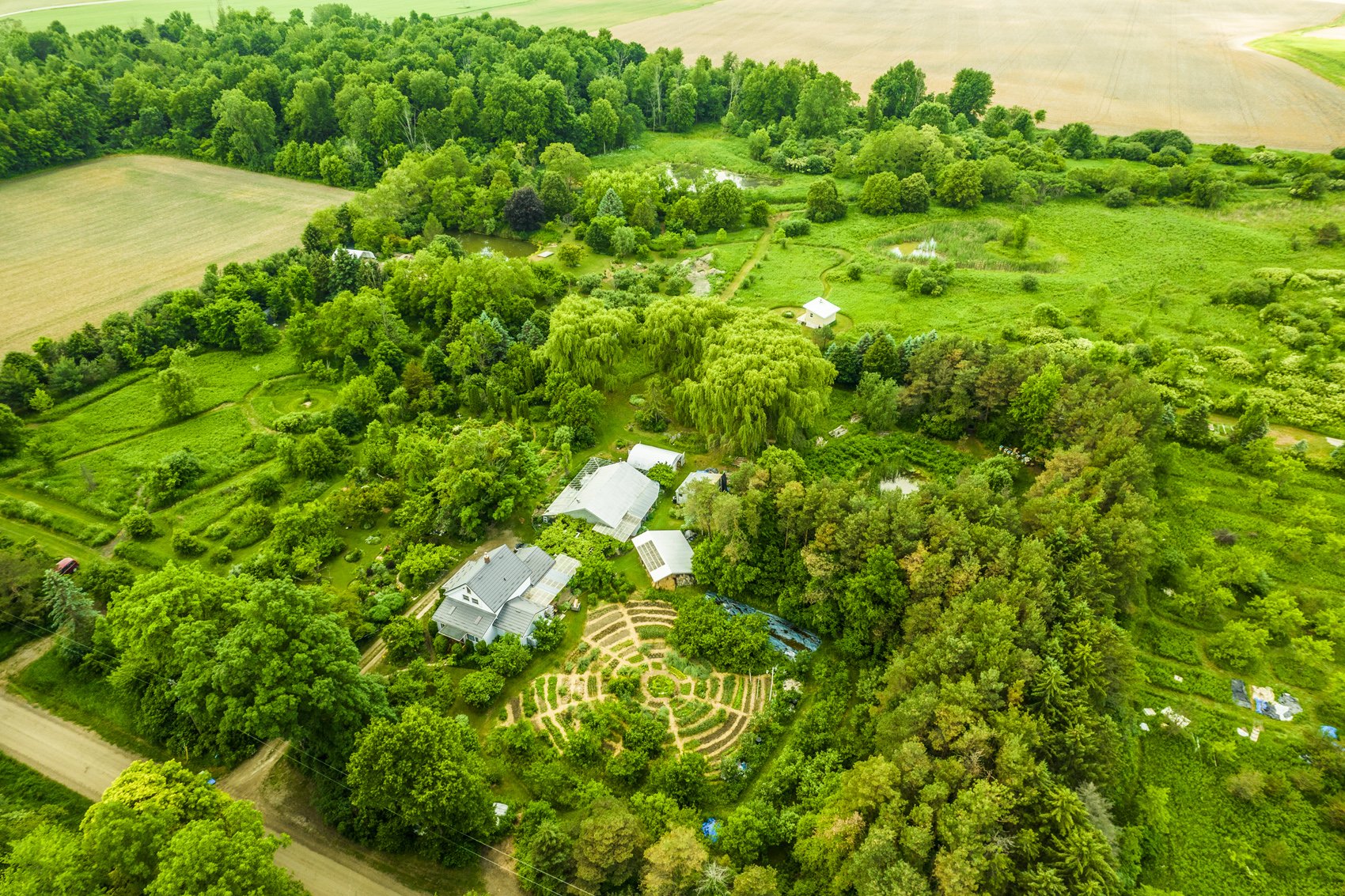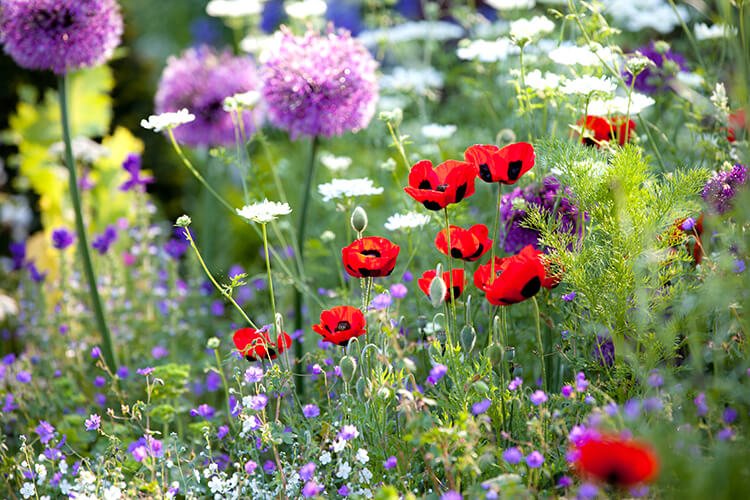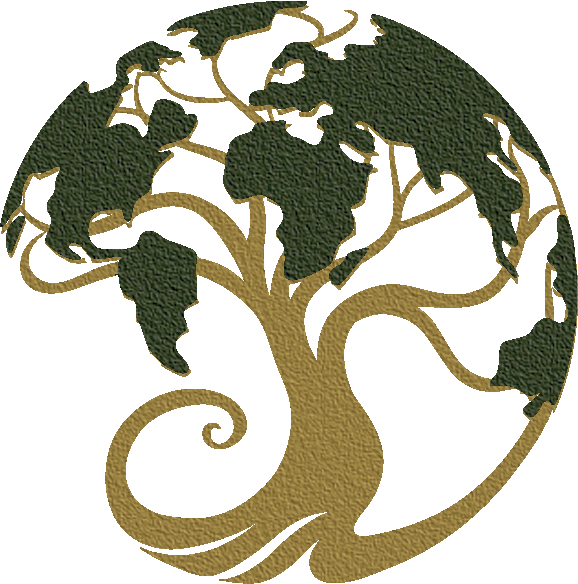
Our Forest Garden Historical Timeline
(Established 1983)
Longer Version of our Forest Garden Historical Timeline
The Dream
In 1975, Shantree Kacera embarked on a visionary journey, dreaming of cultivating an organic piece of land where he could harmonize with nature and embrace the essence of sustainable living. Fueled by a deep longing to live off the land and embrace a life of abundance, Shantree's aspirations began to take shape.
By 1977, Shantree had meticulously outlined an action plan to manifest his dream. With unwavering determination and a clear vision, he sketched the steps necessary to bring his aspirations to fruition.
1982 marked a pivotal moment in Shantree's journey as the vision he had nurtured for years was on the brink of realization. A small tree nursery had been lovingly planted in his parents' backyard garden, symbolizing the seeds of his aspirations taking root and beginning to flourish.
In 1997, Lorenna Bousquet joined the dream at The Living Centre, bringing with her a profound commitment and love for the land. Her presence marked a significant turning point, as she became deeply involved in various initiatives to nurture and revitalize the natural landscape.
Lorenna's unwavering dedication was pivotal in elevating the gardens' aesthetic appeal, transforming them into vibrant sanctuaries of biodiversity and serenity. With her keen eye for detail and creative vision, she meticulously curated spaces that captivated the senses and provided sanctuary for various plant and animal species.
This is the story of the land…
History
Over the decades, Shantree, Lorenna and a community of folks cultivated a productive forest garden for educational research, design, and propagation. The site in southwestern Ontario's Carolinian Canada spans 50 acres. It features diverse elements like a mature heritage forest, self-reviving areas, wildflower meadows, pear orchards, vegetable and herb gardens, and semi-wild edible forest gardens around a pond.
The property boasts diverse soil types—from hard clay and sandy soil to rich black muck—and various features like a pond, stream, wetland, and swamp. The climate, influenced by Lake Erie, exhibits distinct seasons, with growing months from April to November.
Research and planning, initiated in the 1980s, led to planting mixed fruit and nut orchards and cultivating medicinal herbs, with a primary focus on organic garlic. The experiment included diverse species like persimmons, kiwi, quince, apricots, peaches, nectarines, pawpaw, figs, jostaberries, currants, gooseberries, grapes, and goji berries.
Windbreaks were strategically placed, and fertility was enhanced through mulch, compost, and plant amendments. Maintaining over 1000 trees and shrubs became a priority as the operation expanded. The forest garden, with layers ranging from canopy to shrubs, herbs, roots, and ground covers, faced challenges like wildlife and weather, but ongoing maintenance ensured its success.
The site, with a hardiness zone of 6A, experienced varying soil conditions and weather patterns, including high winds, rainfall, snowfall, and drought conditions. Despite challenges, Shantree's vision for the forest ecosystem is aimed at ecological diversity, social support, and economic viability.
Future visions for the research and education centre, in general, are reflected in the forest garden goals and include:
·Emphasizing continuing Research in local native foods and medicines
·Regenerating the property
·Serving as an educational property and a living classroom
·Community Gathering
·Serving as a sacred space
· Research and demonstration
Final Thoughts
This forest gardening project has been an ongoing creative endeavour with lots of learning and hard physical work, with hundreds of students and apprentices involved. There is much to discover about forest ecology and the individual plants and trees; this is a life journey. The one thing that keeps me going is a desire to create a more peaceful, healthier, and happier world for future generations.
Fruit Tree Inventory
Fruit Tree
Number & Details
Pear
120 Bosc & Bartlett semi-dwarf trees (the oldest being about 40 years old)
Pear
10 trees of various types (various ages, the oldest being about 45 years old)
Apple
20 trees assorted (12 to 15 years old)
Cherry
25 trees (4 trees about 50 years old; the rest are of various ages)
Plums
12 trees (5 trees are about 20 years old, the rest are of various ages)
Apricots
20 trees (various ages, the oldest ones being about 35 years old)
Peaches
10 trees (various ages, the oldest being about 20 years old)
Nectarines
5 trees (various ages, the oldest being about 10 years old)
Quince
10 trees (various ages, the oldest being about 15 years old)
June Berry
5 trees (various ages, the oldest being about 10 years old)
Cranberry
1 tree (about 5 years old)
Mulberry
5 trees (various ages, the oldest being about 20 years old)
Pawpaw
10 trees (various ages, the oldest being about 10 years old)
Persimmon
2 trees (the oldest being about 5 years old)
Fig
10 trees (various ages, the oldest being about 12 years old)
Goji Berries
5 Vines (various ages, the oldest being about 7 years old)
Kiwi Vines
5 Vines (various ages, the oldest being about 20 years old)
Grape Vines
10 vines (various ages, the oldest being about 30 years old)
APPROXIMATE TOTAL
300 TREES & VINES
Nut Tree Inventory
Nut Tree
Number & Details
Filberts
12 semi-dwarf trees (various ages, the oldest being about 40 years old)
Turkish Hazelnut
4 trees (various ages, the oldest being about 5 years old)
Heartnut
10 trees (various ages, the oldest being about 5 years old)
Northern Pecan
3 trees (various ages, the oldest being about 5 years old)
Walnut
10 trees (various ages, the oldest being about 40 years old)
English Walnut
4 trees (various ages, the oldest being about 30 years old)
Ginkgo Nut
5 trees (various ages, the oldest being about 35 years old)
Butternut
3 trees (various ages, the oldest being about 60 years old)
American Chestnut
1 tree (approximate age being about 15 years old)
Swamp Oak
3 trees (various ages, the oldest being about 5 years old)
Bur Oak
3 trees (various ages, the oldest being about 5 years old)
Almond
1 tree (about 2 years old)
APPROXIMATE TOTAL
60 TREES
Historical Timeline
1982
Dreaming in the Forest Garden
Started a Small Tree Nursery
1983
Moved onto the property Summer Solstice, June 21st
Clearing up the property
Taking out the trash
1984
Started one organic vegetable garden
Pruned back a very neglected pear orchard
Designed a circular medicine wheel herb garden
1985
Planted a half-acre medicine wheel herb garden
Build a grape arbour, followed by planting a few varieties of grapes
Finished repairing a small, unfinished greenhouse
1986
Planted a few English walnuts and other hard-to-find fruit trees
Planted a two-acre vegetable garden
Planted a one-acre cash crop of garlic
1987
Expanded to planting two acres of garlic
Redesigned and expanded herb garden to one acre
Planted ‘May Peace Prevail on Earth’ pole
1988
The focus begins to be more on educating the public on organic food production and herbs.
The Medicine Wheel herb garden has around 500 species of medicinal plants and is beginning to get attention.
We started planting more trees from the tree nursery (between 50 to 100 trees a year—an assortment of fruit, nut, medicinal trees, and evergreens to expand windbreaks.
1989
Began focusing on harvesting and wild-crafting medical herbs for healing.
We have created a culinary garden just outside of the kitchen backdoor.
1991
Medicine Wheel Herb Garden becomes known as one of Canada’s most diverse herb gardens, with with numerous write-ups in newspapers and magazines.
Created a rainbow shaped herb tea garden with around 50 varieties.
1992
Expanded tree nursery in diversity and size
1993
For the ten year anniversary th,e centre we had a special celebration around the peace pole.
1994
The beginning of establishing an edible native plant medicine trail (1 kilometre in length around the periphery of the property)
1998
Planted a Sacred Tree Grove around the pond.
1999
We planted 12 apple trees in the north section of the vegetable garden.
2000
Herb garden looks more like a young forest garden.
2001
Began building a 1,000 sq. foot passive solar Earthship greenhouse.
2002
Completed building a 1,000 sq. foot passive solar Earthship greenhouse containing a solarium.
2003
Landscaped around the outside of the Earthship greenhouse.
2004
Build an outdoor summer sprouting kitchen
2005
Designed and planted a new fruit orchard around the pond.
2006
Planted around 30 fruit trees in the periphery of the vegetable garden.
Began planting polycultures around the fruit trees in the new orchard.
2007
The redesigned vegetable garden is a half-acre spiral garden.
Created a spiral garden just north of the pond.
Began reclaiming a semi-wild pear grove at the forest edge.
2008
Created a sacred spiral garden in the middle of the vegetable garden.
Planted heartnut, pecan trees, and other fruit trees around the pond.
2009
Planted a filbert and pawpaw grove near the pond.
Created a sacred space for tipi next to the sacred spiral
Built a tipi just north of and overlooking the pond
2010
Created an herbal spiral outside the kitchen backdoor.
Designed and planted three native garden polycultures.
Planted a pawpaw trail along the south side of the pond.
Designed a semi-wild edible forest landscape in the pear grove. (This is a microclimate with four large heritage pears)
2011
Planted more of an assortment of edible fruit and nut trees around the pond.
A Forest Garden was started in the Old-Growth Forest.
Expanded the tree nursery
2012
Planted another 50 trees such as Almonds, Plumcots, Chums, Everbearing & White Mulberry, Asian Pears, Haspak Berries, Kiwi, Aronia Berries, Cornelia Cherry, Cherry Olives, Cherry Olives, Shrub Cherries, Seaberries, a few more Peaches and Apricots
Tore down the 100-year-old barn
Dreaming, Designing, and planning to build a Bioshelter
2013
Artemisia: Forest Garden Nursery was born
Polycultured a 100-meter Asparagus Patch
2014
Built a Kiwi Walkway
Constructed a Hoophouse
Planted over 100 berry bushes
Expanded Herb Plant, Berry, and tree Nursery around the well
Held the 1st. Annual Forest Garden Convergence
2015
Early stages of a Children’s Children’s Garden
Planted another 100 berry bushes
Inoculated another 100 logs with Oyster Mushrooms and Lion’s MaLion’sd the 3rd. Annual Forest Garden Convergence
Build a Strawbale Studio
Creating a 1 km. Native Plant Trail
Continuing building a Kitty Tool Shed (Earthship, cordwood, and cob)
Complete Kitty Shed
Reconstruct Earthship Greenhouse
Expand Summer Kitchen
Designed and began building Sanctuary
Began building Bathhouse
Continued with Sanctuary
Completed Sanctuary & Bathhouse
To plant more trees!
To plant more peace!
To plant more joy!
2016
Expanded the Summer Kitchen
Held 2nd. Annual Forest Garden Convergence
2017
Pollarded 5 Linden Trees and inoculated logs with Oyster Mushrooms and lion’s MaLion’snted crooked willow archways & willow dome
2018
Planted a Rose-of-Sharon pathway to the tipi area, along with a new sacred spiral entrance to the tipi
2019
Inoculated another 100 logs with Oyster Mushrooms and Lion’s MaLion’sd the 3rd. Annual Forest Garden Convergence
2020
Build a Strawbale Studio
Creating a 1 km. Native Plant Trail
Continuing building a Kitty Tool Shed (Earthship, cordwood, and cob)
Complete Kitty Shed
Reconstruct Earthship Greenhouse
Expand Summer Kitchen
Designed and began building Sanctuary
2021
Continued with Sanctuary
2022
Continued with Sanctuary
2023
Completed Sanctuary & Bathhouse
To plant more trees!
To plant more peace!
To plant more joy!
2024
To plant more trees!
To plant more peace!
To plant more joy!



